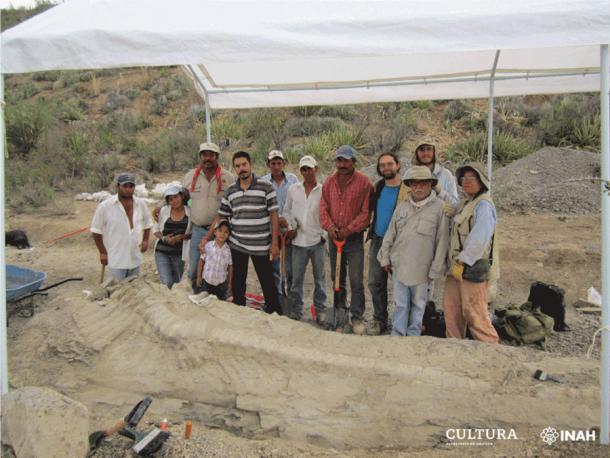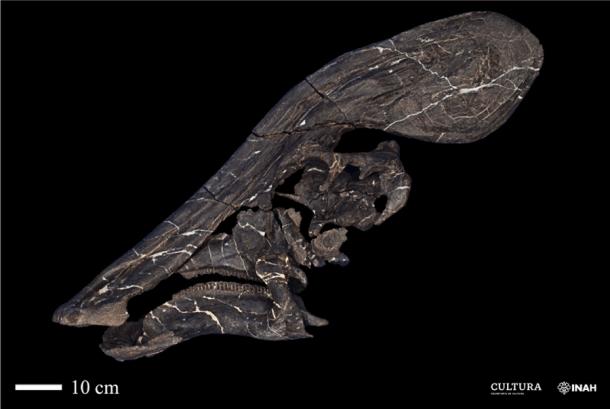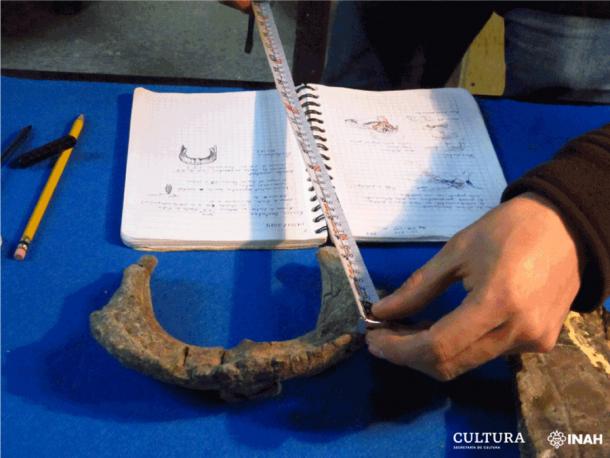The National Institute of Anthropology and History (INAH), Mexico, a part of the Ministry of Culture, along with the National Autonomous University of Mexico (UNAM), launched a project in 2013, to “recover a semi-articulated tail of a putative hadrosaur.” This fossil of a dinosaur in Mexico was discovered in 2005 and is now dated to 72-73 million years ago. The new species of dinosaur in Mexico is outlined and detailed in a recent study published in the scientific journal Cretaceous Research .
The discovery of the dinosaur in Mexico was made in the upper-Campanian deposits of the Cerro del Pueblo Formation, near Presa de San Antonio, General Cepeda Municipality, Coahuila, northern Mexico. It has been identified as a new and unidentified species of dinosaur. What is unique about this new species is that it used low frequency sounds like elephants to communicate, reports British sci-tech publication, Phys.org.

Paleontologists from INAH and UNAM unearthed the tail of the new dinosaur in Mexico in 2013. ( INAH)
The Talkative Dinosaur is a Crested Dinosaur
This new species of dinosaur in Mexico has been give the name, Tlatolophus galorum, meaning a crested dinosaur. The name Tlatolophus is derived from tlahtolli, which means “word” in the indigenous Aztec Nahuatl language , and lophus, meaning “crest” in Greek. The crest’s shape is similar to a “symbol used by Mesoamerican people in ancient manuscripts to represent the action of communication and knowledge itself.” It was defined as a “peaceful but talkative dinosaur.”
“We believe that these dinosaurs were very communicative. They even produced and perceived low-frequency sounds like those made by elephants, which travel several kilometers and are imperceptible to humans,” says palaeobiologist Angel Alejandro Ramirez.
“We know that they had ears with the ability to receive low-frequency sounds, so they must have been peaceful but talkative dinosaurs. Some paleontologists theorize that they emitted loud sounds to scare off carnivores or for reproduction purposes, which suggests that the crests wore bright colors,” said Ramirez.

The skull of the new dinosaur in Mexico and its distinctive Tlatolophus crest bone. (Juan Miguel Contreras, technical photographer, Institute of Geology / INAH)
What Scientists Are Saying About the New Dinosaur in Mexico
The ability to communicate using low frequency sounds is not Tlatolophus galorum’s only distinctive trait. It also had a high skull, a wide premaxilla (a pair of small cranial bones at the very tip of the upper jaw of many animals), a low dorsal apex, and an elongated nasal cavity.
The discovery of the new dinosaur in Mexico was miraculous, considering that parts of the bone structure were exposed to the topsoil and the decomposing forces of nature for such a long time. “Highly favorable events had to occur millions of years ago, when Coahuila was a tropical region, for it to be conserved in the conditions it was found in,” according to INAH.
Rescuing the skeleton of the new dinosaur in Mexico was a priority, as some vertebrae were protruding from the top soil, according to Instituto Nacional de Antropologia e Historia . Eighty percent of the skull was retrieved (including the lower and upper jaws, palate and the neurocranium), making it possible to claim it as an unidentified genus and the first parasaurolofino (meaning, close to the crested lizard) reported in Mexico. The skull is 1.32 meters (4.3 feet) long, in the shape of a bony, hollow crest.
“Although we had lost hope of finding the top of the specimen, once we recovered the tail we continued digging under where it was located. The surprise was that we began to find bones such as the femur, the scapula and other elements,” said Ramírez Velasco, one of the many co-authors of the study. The first classification was not that of a new species. Instead, it was assumed that this was a hardrosaurus dinosaur, which had been previously identified as living in North America.

Examinations of various bones that were recovered from the new dinosaur in Mexico allowed the researchers to assert this is a new species. ( INAH)
This discovery is one of a handful of the world’s limited collection of intact dinosaur fossils, according to Live Science . The specimen is a gorgeous one with scientists speculating it to be that of a large individual, about 12 meters (39.3 feet) in length. They deduced this from assessing the scapular neck, which was relatively stout, and the iliac postacetabular process (the extension of the animal from the hip onwards), which was long.
Dinosaurs are a reptile group that emerged somewhere between 243 and 233.23 million years ago during the Triassic period , becoming the dominant terrestrial vertebrates after the Triassic-Jurassic extinction event 201.3 million years ago. Today’s birds are, in fact, modern feathered dinosaurs that evolved from their ancestor group over millions of years. Birds are the only surviving dinosaur lineage on earth.
Top image: Representation of the new dinosaur in Mexico that is now known as a new species of ancient reptiles known as Tlatolophus galorum. Source: Luis V. Rey / INAH
By Rudra Bhushan
Related posts:
Views: 0
 RSS Feed
RSS Feed

















 May 26th, 2021
May 26th, 2021  Awake Goy
Awake Goy 



 Posted in
Posted in  Tags:
Tags: 
















